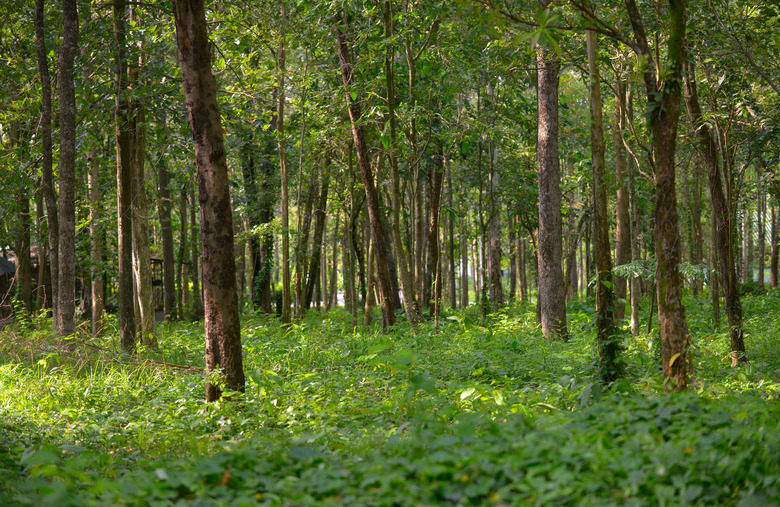Tropical Deciduous Forest Animals & Plants
Unlike other tropical forests, tropical deciduous forests are defined by the presence of broad-leaved tree species and climatic conditions that include a long dry season, in addition to their tropical latitude. Sometimes referred to as tropical dry forests, these ecosystems rely on cyclical drought to precipitate the shedding of leaves. Found in countries around the world, tropical deciduous forests play host to an astounding variety of distinct plant and animal species.
Northern Mexico
Northern Mexico
Stretching from Arizona deep into the state of Sonora, the tropical deciduous forest of northern Mexico covers an immense area rich in plant and animals species. Dominated by tree species such as alligator-bark juniper (Juniperus deppeana) and hand-basin oak (Quercus tarahumara), the forest is defined by the presence of these trees yet also includes a variety of distinctive evergreen succulent plants such as sahueso (Pachycereus pringlei). The tallest species of cacti in the world, sahueso can grow to 60 feet in height under ideal circumstances. Numerous animals species such as the ringtail (Bassariscus astutus) and collared peccary (Tayassu tajacu) thrive in the tropical deciduous forest of northern Mexico, in tandem with endangered bird species such as the eared quetzal (Euptilotis neoxenus).
Madagascar
Madagascar
Once dominated by tropical deciduous forest, the western coast of Madagascar is rich in many endemic plant and animal species. Defined by the presence of tree species such as Grandidier's baobab (Adansonia grandidieri), bontaka (Pachypodium baronii) and flamboyant tree (Delonix regia), the forest is home to numerous species of lemur, including Tattersall's sifaka (Propithecus tattersalli). It is one of the smallest sifaka species and was not discovered until 1974. A common predator of Tattersall's sifaka, the fossa (Cryptoprocta ferox) is the largest predatory carnivore in Madagascar. It dwells in tropical deciduous forests around the island, competing for prey with the Madagascar fish eagle (Haliaeetus vociferoides). Once common along the west coast, the Madagascar sea eagle is now rare throughout its native range.
Central India
Central India
Fragmented bands of tropical deciduous forests still exist across central India despite having long been exploited for lumber and food. Comprised of species such as the shala tree (Shorea robusta), kino tree (Pterocarpus marsupium) and jambul (Syzygium cumini), the forest provides rich habitat for many animals species, among them the sloth bear (Ursus ursinus), chousingha (Tetracerus quadricornis) and dhole (Cuon alpinus). Large and shaggy, sloth bears are an unusual bear species known for their long hair and white chest markings. Feeding mainly on termites and honey, sloth bears lack front teeth to better slurp termites from their hives. Living in tandem with the sloth bear, the chousingha is a diminutive antelope species known for its ability to grow four horns. It is a common prey animal for the dhole, an unusual canid species found throughout Asia. With their stocky build and short stature, dholes superficially resemble domestic dogs but are fierce predators.
New Caledonia
New Caledonia
A little known tropical deciduous forest covers much of the southern Pacific island of New Caledonia. Located off the east coast of Australia, New Caledonia's tropical deciduous forest is dominated by five species of southern beech (Nothofagus sp.), a genus of beech trees found only in the southern hemisphere. In addition to southern beeches, tree species such as thatch screwpine (Pandanus tectorius) and queen sago (Cycas circinalis) are found along the mountain slopes and valleys of the island. The island harbors no terrestrial mammals but a wide variety of bats thrive there, including the New Caledonia flying fox (Pteropus vetulus). Once abundant on the island, New Caledonia flying foxes are now endangered due to competition and predation from introduced species. Another unusual endemic species of the island, the New Caledonian giant gecko (Rhacodactylus leachianus) is the largest species of gecko in the world. Exceeding one-foot in length, it is an elusive species that dwells high in the forest canopy.
References
- "Seasonally Dry Tropical Forests"; Stephen H. Bullock; 1998
- "The Illustrated Encyclopedia of Trees of the World"; Catherine Cutler; 2007
- "Grzimek's Animal Life Encyclopedia"; Dr. Bernhard Grzimek; 2007
- "Tropical Forest Biomes"; Barbara A. Holzman; 2009
Cite This Article
MLA
Degnan, Sasha. "Tropical Deciduous Forest Animals & Plants" sciencing.com, https://www.sciencing.com/tropical-deciduous-forest-animals-plants-13427790/. 22 November 2019.
APA
Degnan, Sasha. (2019, November 22). Tropical Deciduous Forest Animals & Plants. sciencing.com. Retrieved from https://www.sciencing.com/tropical-deciduous-forest-animals-plants-13427790/
Chicago
Degnan, Sasha. Tropical Deciduous Forest Animals & Plants last modified March 24, 2022. https://www.sciencing.com/tropical-deciduous-forest-animals-plants-13427790/
